Abstract
A new system of lymphocyte alloantigens in mice is described. This Lna (lymph-node antigen) system is associated with the Ir region of the H-2 (histocompatibility-2) gene complex. It has the following distinctive characteristics: (1) The gene or genes controlling these antigens has been mapped in the Ir (immune response) region between H-2K and Ss-Slp. (2) The antigens are most readily detectable on lymph-node cells, although they are also expressed on peripheral blood lymphocytes, splenic lymphocytes, and thymocytes. (3) Cytotoxicity against only about half of lymph-node cells is consistently observed. (4) Cytotoxic antibody titers against these antigens are strikingly high—more than 2000 by 51Cr-release and up to 100,000 in the microcytotoxic test. (5) At least two, probably allelic, forms of the antigen(s) have been defined, one associated with the H-2k haplotype and one with the H-2a haplotype. (6) Antisera against Lna contain multiple antibody specificities that can be fractionated by absorption either with certain recombinants or with other H-2 halotypes that have crossreactive antigens. The antisera against Lna may be of value for definition and characterization of the products of the Ir and MLR (mixed lymphocyte reaction stimulatory) genes associated with the H-2 complex.
Keywords: histocompatibility, transplantation antigens, immune response genes
Full text
PDF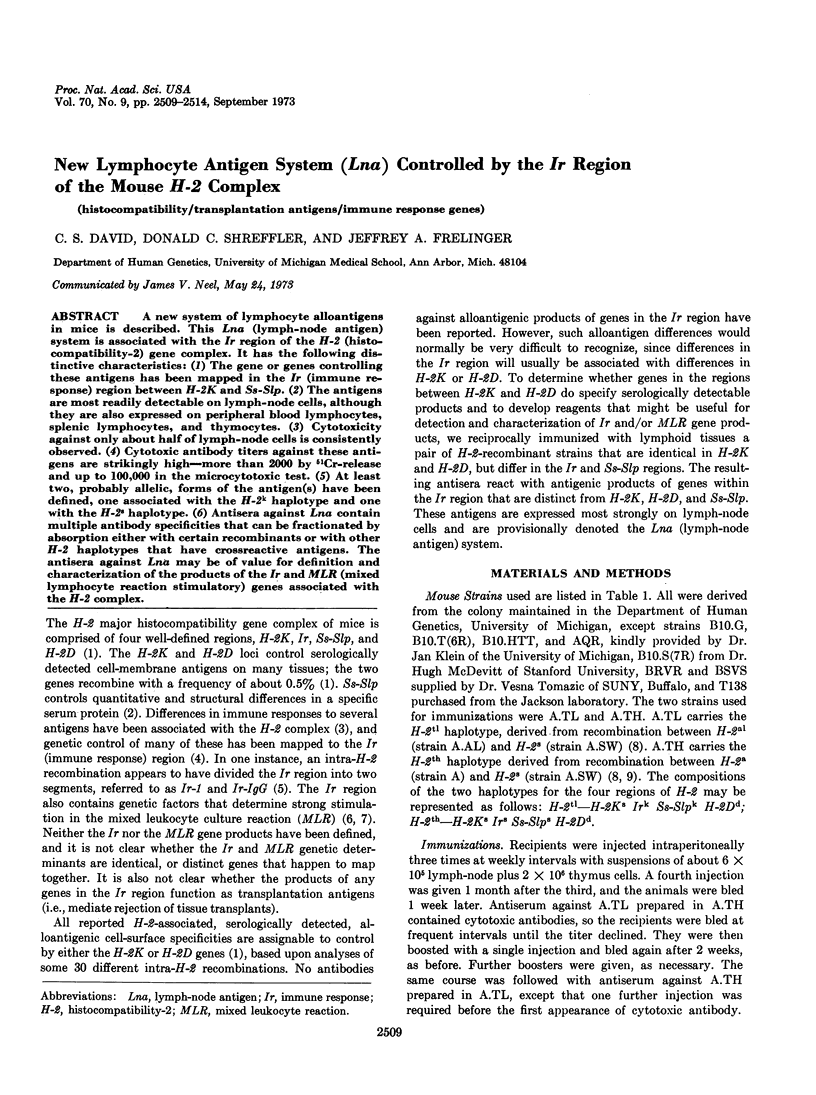
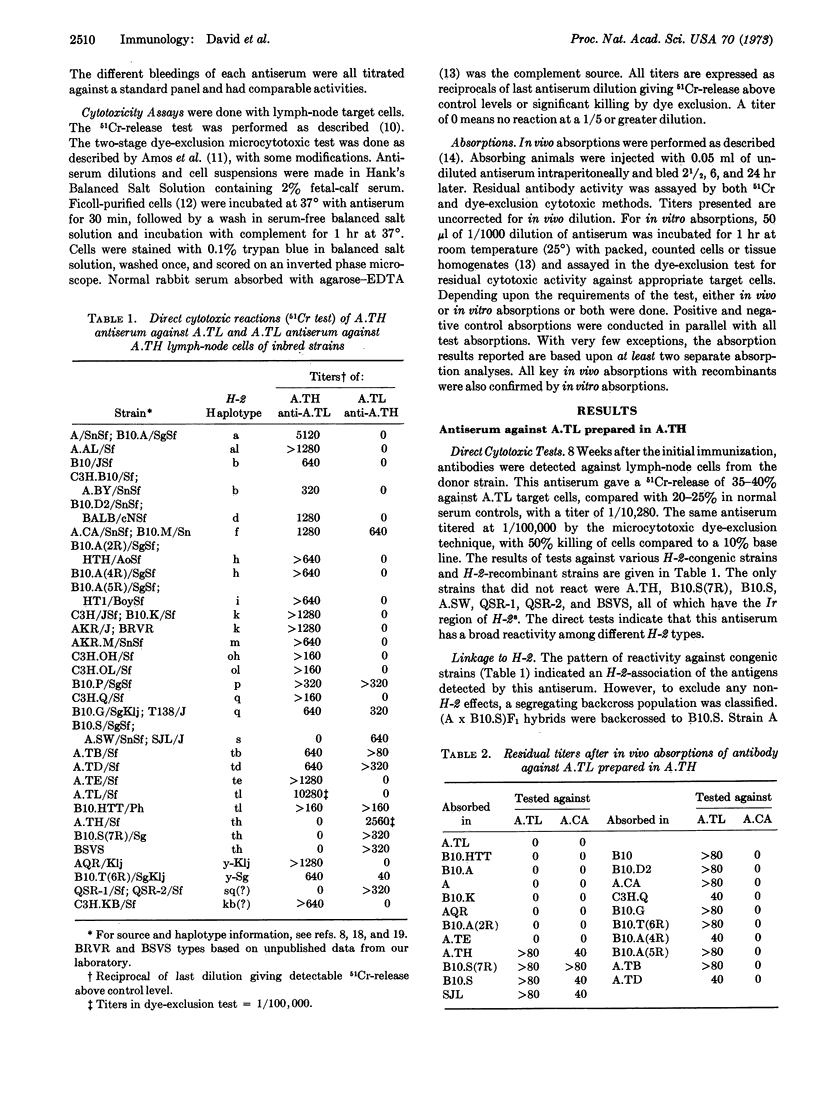

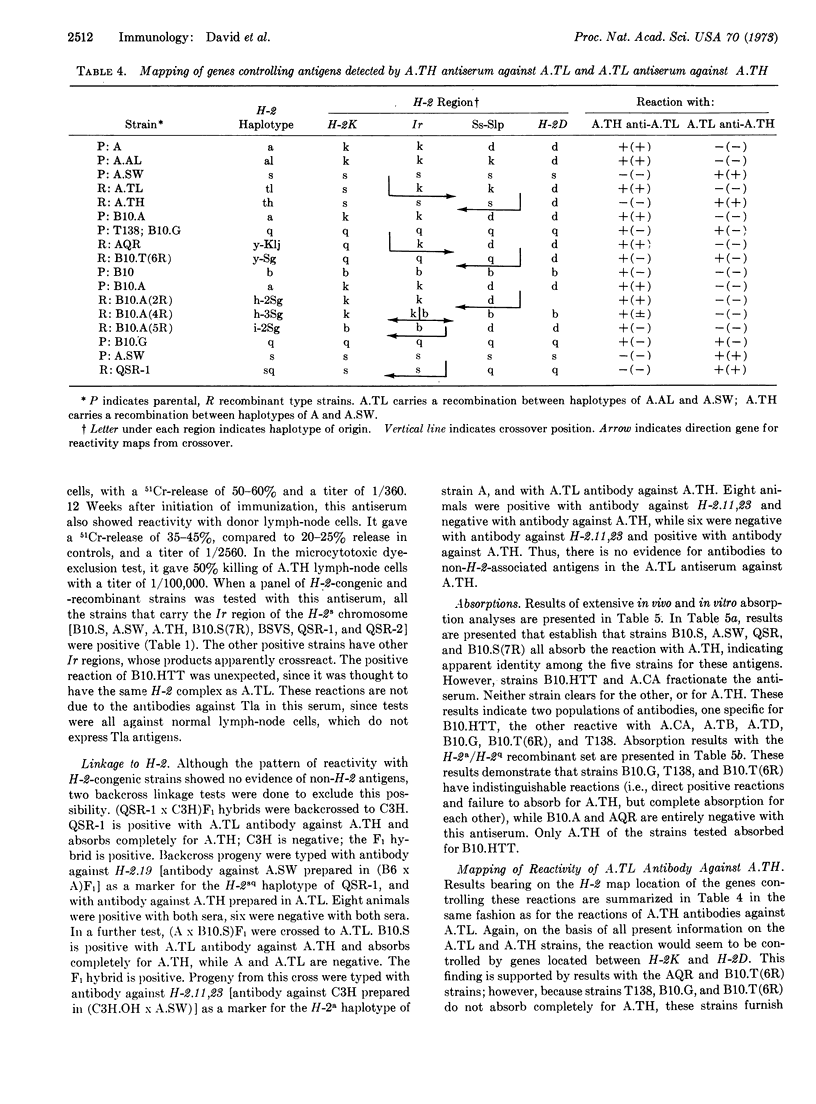
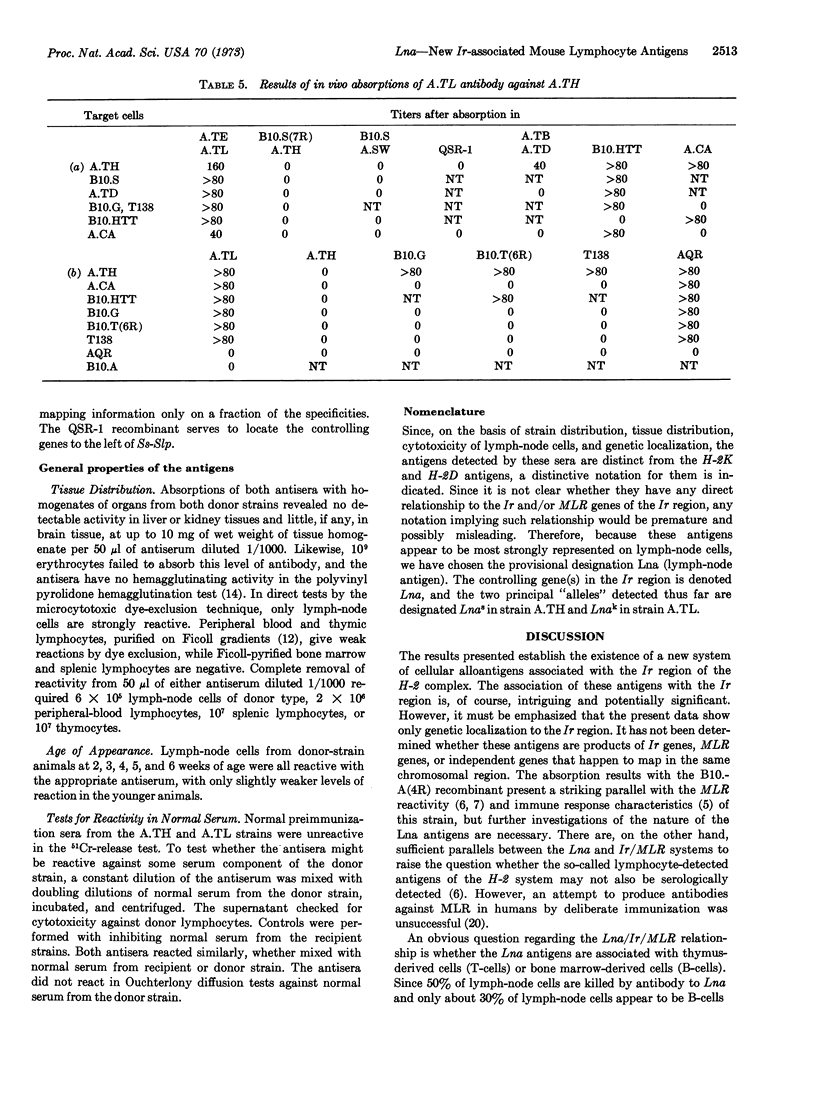
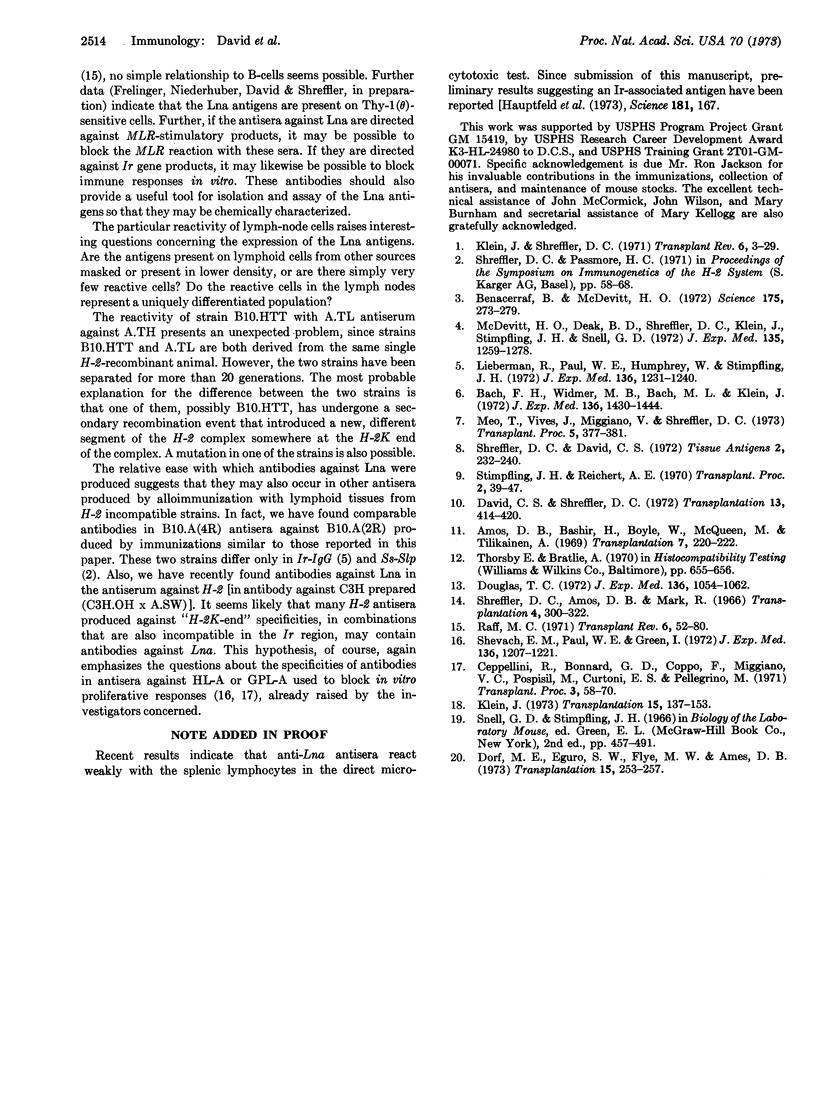
Selected References
These references are in PubMed. This may not be the complete list of references from this article.
- Amos D. B., Bashir H., Boyle W., MacQueen M., Tiilikainen A. A simple micro cytotoxicity test. Transplantation. 1969 Mar;7(3):220–223. doi: 10.1097/00007890-196903000-00023. [DOI] [PubMed] [Google Scholar]
- Bach F. H., Widmer M. B., Bach M. L., Klein J. Serologically defined and lymphocyte-defined components of the major histocompatibility complex in the mouse. J Exp Med. 1972 Dec 1;136(6):1430–1444. doi: 10.1084/jem.136.6.1430. [DOI] [PMC free article] [PubMed] [Google Scholar]
- Benacerraf B., McDevitt H. O. Histocompatibility-linked immune response genes. Science. 1972 Jan 21;175(4019):273–279. doi: 10.1126/science.175.4019.273. [DOI] [PubMed] [Google Scholar]
- Ceppellini R., Bonnard G. D., Coppo F., Miggiano V. C., Pospisil M., Curtoni E. S., Pellegrino M. Transplantation antigens: introductory symposium. Mixed leukocyte cultures and HL-A antigens. I. Reactivity of young fetuses, newborns and mothers at delivery. Transplant Proc. 1971 Mar;3(1):58–63. [PubMed] [Google Scholar]
- David C. S., Shreffler D. C. Adaptation of the 51 CR cytotoxic assay for rapid H-2 classifications on peripheral blood cells. Transplantation. 1972 Apr;13(4):414–420. doi: 10.1097/00007890-197204000-00009. [DOI] [PubMed] [Google Scholar]
- Dorf M. E., Eguro S. Y., Flye M. W., Amos D. B. Serological studies of phenotypically HL-A-identical unrelated subjects. Transplantation. 1973 Feb;15(2):253–257. doi: 10.1097/00007890-197302000-00013. [DOI] [PubMed] [Google Scholar]
- Douglas T. C. Occurrence of a theta-like antigen in rats. J Exp Med. 1972 Nov 1;136(5):1054–1062. doi: 10.1084/jem.136.5.1054. [DOI] [PMC free article] [PubMed] [Google Scholar]
- Hauptfeld V., Klein D., Klein J. Serological identification of an Ir-region product. Science. 1973 Jul 13;181(4095):167–169. doi: 10.1126/science.181.4095.167. [DOI] [PubMed] [Google Scholar]
- Klein J. List of congenic lines of mice. I. Lines with differences at alloantigen loci. Transplantation. 1973 Jan;15(1):137–153. doi: 10.1097/00007890-197301000-00021. [DOI] [PubMed] [Google Scholar]
- Klein J., Shreffler D. C. The H-2 model for the major histocompatibility systems. Transplant Rev. 1971;6:3–29. doi: 10.1111/j.1600-065x.1971.tb00457.x. [DOI] [PubMed] [Google Scholar]
- Lieberman R., Paul W. E., Humphrey W., Jr, Stimpfling J. H. H-2-linked immune response (Ir) genes. Independent loci for Ir-IgG and Ir-IgA genes. J Exp Med. 1972 Nov 1;136(5):1231–1240. doi: 10.1084/jem.136.5.1231. [DOI] [PMC free article] [PubMed] [Google Scholar]
- McDevitt H. O., Deak B. D., Shreffler D. C., Klein J., Stimpfling J. H., Snell G. D. Genetic control of the immune response. Mapping of the Ir-1 locus. J Exp Med. 1972 Jun 1;135(6):1259–1278. doi: 10.1084/jem.135.6.1259. [DOI] [PMC free article] [PubMed] [Google Scholar]
- Meo T., Vives J., Miggiano V., Shreffler D. A major role for the Ir-1 region of the mouse H-2 complex in the mixed leukocyte reaction. Transplant Proc. 1973 Mar;5(1):377–381. [PubMed] [Google Scholar]
- Raff M. C. Surface antigenic markers for distinguishing T and B lymphocytes in mice. Transplant Rev. 1971;6:52–80. doi: 10.1111/j.1600-065x.1971.tb00459.x. [DOI] [PubMed] [Google Scholar]
- Shevach E. M., Paul W. E., Green I. Histocompatibility-linked immune response gene function in guinea pigs. Specific inhibition of antigen-induced lymphocyte proliferation by alloantisera. J Exp Med. 1972 Nov 1;136(5):1207–1221. doi: 10.1084/jem.136.5.1207. [DOI] [PMC free article] [PubMed] [Google Scholar]
- Shreffler D. C., Amos D. B., Mark R. Serological analysis of a recombination in the H-2 region of the mouse. Transplantation. 1966 May;4(3):300–322. doi: 10.1097/00007890-196605000-00008. [DOI] [PubMed] [Google Scholar]
- Shreffler D. C., David C. S. Studies on recombination within the mouse H-2 complex. I. Three recombinants which position the Ss locus within the complex. Tissue Antigens. 1972;2(3):232–240. doi: 10.1111/j.1399-0039.1972.tb00140.x. [DOI] [PubMed] [Google Scholar]
- Stimpfling J. H., Reichert A. E. Strain C57BL-10ScSn and its congenic resistant sublines. Transplant Proc. 1970 Mar;2(1):39–47. [PubMed] [Google Scholar]


